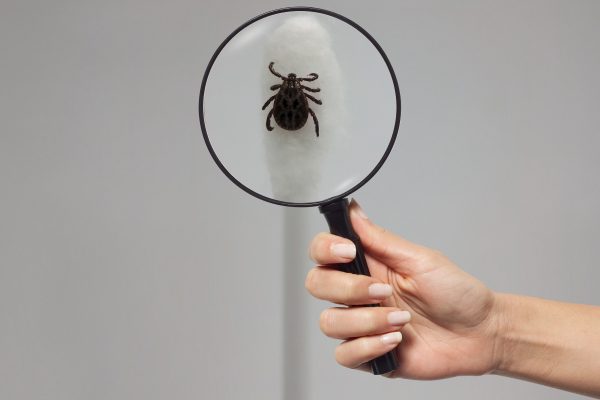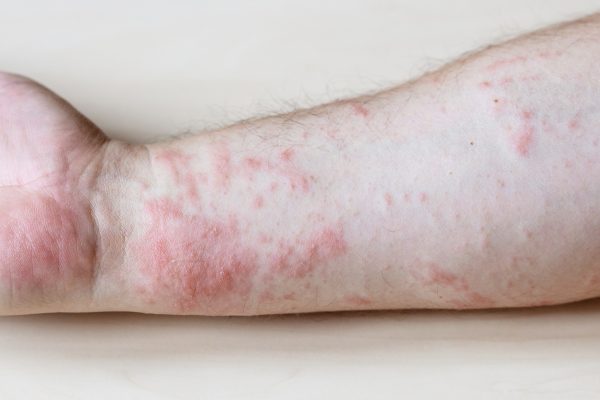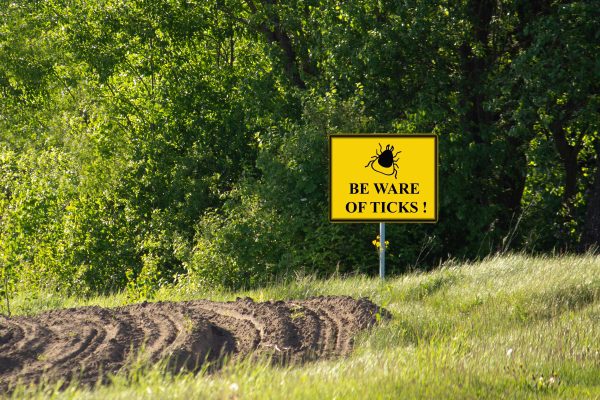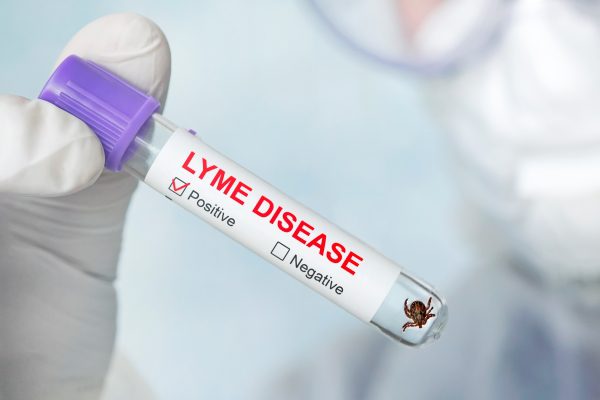Your first experience with Lyme disease might be limited to an itchy red rash that pops up around a tick bite after a walk in the woods.
What if you overlook that bite until weeks later? What if you don’t get the rash and miss all the other signs of Lyme disease? And that’s a significant risk after being outside in tick-heavy areas.
As weird as it sounds, ticks are very shy little guys. They prefer to lurk and hide in grasses, bushes, and shrubs — anywhere they can find an unsuspecting passer and latch on without getting caught.
Once they attach their barbed mouthparts beneath your skin, they feed on your blood until you brush them off or fall off naturally. It sounds like something out of a Grimm fairytale, doesn’t it?

Ticks And Lyme Disease
You might think all there is to know about ticks and their creepy crawly cousins, the spiders. However, it turns out that some of those beliefs are less than accurate.
For example, let’s take the common belief that tick bites don’t pose a danger to humans. Unfortunately, this isn’t exactly true. The risk posed by tick bites is quite substantial. This section will focus on the threats posed by ticks and tick bites and common misconceptions about these little arachnids.
Lyme disease cases are rising in the U.S., with more than 300,000 reported cases yearly. Lyme disease is a severe infection caused by bacteria transmitted to humans by an infected tick bite.
What Is Lyme Disease?
Lyme disease is an infectious disease caused by bacteria called “Borrelia burgdorferi,” transmitted to humans by ticks. Different species of ticks can transmit this disease to humans, including “Ixodes scapularis” (also known as “black-legged ticks”) and “Ixodes pacificus.”
This condition can cause symptoms ranging from mild joint pain to severe neurological issues. The typical symptoms of Lyme disease include fatigue, headaches, joint pain, muscle aches, and irregular heartbeat.
However, about 25% of people don’t show any signs of infection, even after contracting the bacteria. This is why it’s so important to take proper tick precautions.
What Are The Risks Of Contracting Lyme Disease?
Most people are bitten by ticks carrying the bacteria that causes Lyme disease and don’t develop any symptoms. However, about 70-80% will develop a rash (usually between 3 and 30 days after being bitten), and about zero to 50% will experience flu-like symptoms (such as fever, chills, and muscle aches).
If the bacteria spreads to the joints or the heart, it can cause various and more severe symptoms. If not treated, Lyme disease can progress to joint damage, arthritis, heart irregularities, and neurologic problems.
Some people who have been infected report long-term fatigue, joint and muscle pain, and memory problems.
What Is A Tick?
Ticks are small arthropods with eight legs and feed on the blood of humans, animals, birds, and even reptiles. They belong to the order of arachnids, including spiders, mites, and scorpions.
There are over 8,000 ticks worldwide, and they can be found in tropical, subtropical, and temperate areas. Ticks feed on blood to survive but are also carriers of several diseases.
They transmit harmful microorganisms to humans via the bite.
Because of this, ticks are often known as “vectors of disease.” There are more than 35 different types of diseases that ticks can transmit to humans, including Lyme disease, Rocky Mountain spotted fever, tick-borne relapsing fever, tularemia, and babesiosis.
Lyme Disease: A Tick Borne Illness
In medical literature, there are many articles about the connection between ticks and infection. However, there is one disease that’s particularly well-known and well-documentedd ue to its association with ticks:
Lyme disease is an infectious disease caused by bacteria called “Borrelia burgdorferi.” Different species of ticks can transmit this disease to humans, including “Ixodes scapularis” (also known as “black-legged ticks”) and “Ixodes pacificus.”
However, ticks don’t always transmit bacteria to humans; it depends on their development stage, food requirements, and climatic conditions.
How Can Ticks Cause Infection?
When ticks bite humans, they first use their mouth parts to take in blood. After feeding, ticks return to the initial site of feeding to expel the blood. This is when ticks are most likely to transmit bacteria to the host.
However, ticks don’t continuously transmit bacteria to humans. This depends on various factors, such as the species of tick, the bacteria it carries, and the climatic conditions.
There are many ways ticks can transmit disease to humans. Some ticks carry bacteria in their salivary glands, but others don’t. In some cases, ticks can even carry bacteria in their gut. Once the tick bites the host and draws blood, the bacteria is transferred to the host. The transmission process can be quick or slow depending on the type of bacteria and tick.
Other Diseases Caused By Ticks
Apart from Lyme disease, ticks can transmit other diseases to humans, such as Rocky Mountain spotted fever, tick-borne relapsing fever, tularemia, or babesiosis.
In some cases, ticks can also transmit viral diseases, such as Colorado tick fever, Ehrlichiosis, and tick-borne encephalitis.

Rocky Mountain Spotted Fever
This is a bacterial disease that can cause mild symptoms or even death.
About 10% of Rocky Mountain spotted fever people don’t show any symptoms. Tick-borne relapsing fever: This disease is caused by bacteria called “spirochetes,” found in ticks’ blood.
Humans contract tick-borne relapsing fever when they are bitten by ticks that carry these bacteria. Lice can also transmit bacteria.
Tularemia
This is a bacterial disease that ticks can transmit. The bacteria “Francisella tularensis” is present in the ticks’ blood. Humans contract tularemia when they are bitten by ticks that carry the bacteria.
Babesiosis
This is a type of infection that causes anemia and fatigue. It can be transmitted through ticks as well as mosquitoes. This tick-borne disease is caused by a parasite called “Babesia microtia.”
Borrelia Burgdorferi Infection
Borrelia burgdorferi is a bacteria that’s spread by ticks. It’s responsible for causing Lyme disease, a condition that can have several different symptoms, including flu-like symptoms (fever, chills, and joint aches), headaches, muscle aches, and fatigue.
It can also cause neurological problems like nerve pain. Some people with Lyme disease will have a bull’s eye rash on their skin, but many people won’t have a rash at all.
Canine Granulocytic Anaemia
Ticks can transmit a bacteria called Mycoplasma haemocanis. This bacteria is the cause of canine granulocytic anemia.
In dogs, this condition causes an increased number of granulocytes in the blood. Granulocytes are white blood cells that are usually part of the immune response. They are usually infrequent in the blood, but dogs with granulocytic anaemia make up a large proportion of the white blood cells.
Ehrlichiosis
Ehrlichiosis is caused by a bacteria called Ehrlichia. The bacteria are transmitted to dogs when infected ticks bite them. The bacteria can cause serious illness in dogs, especially puppies.
Puppies under six months of age are at the highest risk for complications from Ehrlichiosis. Infected dogs may have none, some, or all of these symptoms: Fever, fatigue, weight loss, low appetite, cough, joint pain, or swelling.
Some dogs may also develop nervous system problems like seizures, difficulty walking, or inability to stand. If left untreated, ehrlichiosis can be fatal.
Human Granulocytic Anaemia
Human granulocytic anaemia is caused by a bacteria called HGE. The disease is sporadic, and it is unclear how it is transmitted from ticks to humans. The disease is treatable with antibiotics.
How Can Ticks Transmit Disease To Humans?
Apart from bacteria, ticks can transmit viral diseases to humans as well. However, ticks are most likely to transmit bacteria, as viruses are more likely to remain inside the tick and not be transmitted to humans.
Within ticks, there are many bacteria and viruses; however, only a small percentage of them transmit diseases to humans. The bacteria and viruses are transported to the salivary glands of the tick, which are then transmitted to the host when the tick bites.
However, some viruses are transmitted to the tick’s gut instead of the salivary glands. In this case, the viruses are excreted with the feces of the tick. The feces are then transmitted to the host when the tick bites.
Ticks And Lyme Disease: What You Should Know
If ticks are so dangerous, why are they not talked about more? The simple answer is that ticks are not insects, so most people don’t recognize them as a risk.
Many people don’t even know what ticks look like. People don’t commonly see them in their daily lives, so they don’t associate the threat of ticks with their everyday lives.
Unfortunately, ticks can pose a real threat to human health.
Although it is possible to prevent tick diseases with the proper precautions, many people still don’t know how to protect themselves from ticks.
Ticks are arachnids that feed on the blood of humans, animals, birds, and even reptiles. They can transmit harmful microorganisms to humans via a bite, including Lyme disease.
The best way to protect yourself from ticks is to become aware of tick prominent areas and to check your body for ticks after spending time outdoors. Once you find a tick, you should remove it as quickly as possible.
Understanding The 3 Stages Of Lyme Disease And How To Be Prepared For Each
There are hundreds of different types of ticks that can carry a variety of diseases.
In the U.S., three main tick species can transmit various viruses and bacteria, including those that cause Lyme disease. The risk of contracting Lyme disease is highest in areas where ticks thrive.
To help you understand what it means to have Lyme disease and how to protect yourself from this bacterial infection, we’ll explain the stages of Lyme disease and how to prevent contracting it.
3 Stages Of Lyme Disease
When we talk about the stages of Lyme disease, we’re talking about the stages of the infection caused by bacteria.
That’s why it’s important to catch Lyme infection early and seek treatment. The three stages of Lyme disease are: Early localized Lyme disease, early disseminated Lyme disease, and late Lyme disease.
Early Localized Lyme Disease
When you get bitten by a tick that carries the bacteria that causes Lyme disease, it’s possible that you won’t get sick at all. You may not even know that the tick was there. It’s also possible that you might notice the tick attached to you and immediately remove it.
If you remove the tick within 24 hours, you’ve likely avoided contracting the disease. However, if the tick was attached for 36 hours or more, it’s possible that it transmitted the bacteria to you.
If you notice the presence of a Lyme disease rash, you can be sure that the bacteria has been transferred to your bloodstream.
Early Disseminated Lyme Disease (EDLD)
Early disseminated Lyme disease (EDLD) is the second stage of Lyme disease. If you’ve contracted the bacteria, it will begin to spread throughout your body.
EDLD can present itself in various ways, including joint pain, muscle aches, headaches, neck stiffness, and cognitive issues. If the bacteria spread to your nervous system, you may experience numbness, tingling, or weakness in your arms or legs.
You may have trouble speaking or swallowing as EDLD progresses. If left untreated, the bacteria can cause brain and spinal cord inflammation, leading to paralysis or cognitive impairment.
Late Lyme Disease
Late Lyme disease is the most advanced stage of Lyme disease. If you’ve reached the third stage of Lyme disease, you’re likely experiencing serious and long-lasting symptoms.
In addition to the symptoms of EDLD, late-stage Lyme disease can also cause heart palpitations, blood pressure issues, and joint pain that may be so severe that you cannot walk. In rare circumstances, the bacteria that causes Lyme disease can lead to death.
Treating Early Stage Lyme Disease
The earlier you notice the signs of Lyme disease, the easier it will be to treat it. If you wait until later to seek treatment, your situation can become more complex and challenging, so it’s best to catch Lyme disease as soon as possible.
If you’ve been bitten by a tick and have noticed any signs of early Lyme disease, it’s best to see a doctor as soon as possible. Not all doctors will know to look for a Lyme disease rash, so it’s important to let them know that you think you may have contracted the disease.
Help For Those With Late-Stage Lyme Disease
If you’ve contracted Lyme disease and made it to the third stage, you’re likely experiencing severe symptoms. This can make it difficult to work and function on a day-to-day basis. Once the bacteria has spread to your central nervous system, this is the stage where more ongoing and consistent support is essential to get ahead of these health complexities.
At this point, you may have to consider other treatments. The best way to prevent Lyme disease is to avoid ticks in the first place. Stay vigilant when you’re outside, and check yourself and your pets after being outside.
If you do contract Lyme disease, get treatment as soon as possible. The longer you wait, the harder it will be to manage the disease.
Protecting Yourself From Getting Lyme Disease
There are steps you can take to protect yourself from contracting Lyme disease, including:
– Wearing long sleeves and pants when walking through areas where ticks like to live and feed.
– Check your skin regularly for ticks, especially if you’re outside.
– Using insect repellent with DEET to keep ticks away.
– Cleaning your clothes and gear after being outside.
– Using a microscope or culturing kit to test your gear for ticks.
– Spraying your lawn for ticks and treating your gear with an insecticide spray.
– Using a wood chip barrier to protect your lawn from ticks.
How To Protect Yourself From Ticks
The most important thing to do is to protect yourself from ticks. When heading into areas where ticks are expected, you can do a few things to protect yourself and considerably lower your chances of contracting Lyme disease.
The first thing you can do is wear long sleeves and pants. This will prevent ticks from crawling up your legs and getting to your skin. You can also spray your clothes with a repellent and your skin with a repellent or anti-tick cream.
When walking in grassy areas, walk in the center of the trail to avoid walking through tall grass. Ticks usually live on the ground and climb up to the host when the opportunity arises. You should also check yourself for ticks after being in areas where ticks are common.
Tick Protection Tips
Ticks are arachnids known for their ability to burrow into the skin of mammals. Unfortunately, tick bites are not as common as other insect bites.
Even so, anyone can be exposed to ticks if they spend time in areas where ticks thrive or come into contact with any animal that could carry ticks. Keep reading to learn how to protect yourself from ticks and reduce the risk of contracting a tick-borne disease.
Inspecting Your Body After Being Outdoors
Always check your skin and clothing after spending time outdoors in areas where ticks are common. Pay extra attention to areas where ticks are more likely to be found, such as the back of the legs, armpits, and scalp. If you find any ticks on your body, remove them as quickly as possible.
If you find a tick on your skin, avoid squeezing it because you could increase your risk of contracting a tick-borne disease. Instead, use fine-tipped tweezers to remove the tick gently. Once the tick is removed, clean the area with an antiseptic and apply an antibiotic ointment as a precaution.
If you have outdoor pets, check them for ticks daily. Even if your pet doesn’t go outside, ticks can find their way into your house and onto your pet.
Using Tick Repellents
Tick repellents can be applied to your clothing, shoes, and skin to help repel ticks. Repellents containing DEET are effective at preventing ticks from attaching to your skin.
DEET-based repellents are considered safe when used as directed. If you’re using a DEET-based product, follow the instructions on the product label to avoid skin contact and overexposure.
Tick repellents also contain permethrin, which kills ticks on contact. Permethrin-based repellents can be applied to clothing and should be washed off before each wear to prevent skin contact.
If you have outdoor pets, you can use a permethrin-based tick repellent on their fur to prevent ticks from attaching to them.
Wearing Protective Clothing
Wearing pants and long-sleeved shirts in tick-infested environments can help prevent ticks from coming into contact with your skin. You can also tuck your pants into your socks to ensure ticks stay away from your lower legs.
When choosing to clothe for outdoor activities, look for tick-repellent products that are specifically labeled for use against ticks. You can also spray regular clothing with a tick repellent to help protect against ticks.
Know Where The Ticks Are Located And What They Look Like
Knowing where ticks are most commonly found can help you identify and avoid them. Ticks are most commonly found in wooded, grassy areas and reigons with low brush.
There are many different types of ticks, so it’s important to know what they look like. Adult ticks are typically larger than the size of a pencil eraser. If you notice any ticks on your skin after being outdoors, call your doctor to see if you should be tested for any tick-borne diseases.
There are a few ways to get rid of ticks in your home. You can buy a tick trap, spray your yard with repellent, or hire a professional to do the job for you.
Clean Your Environment
Clean your clothing, bedding, and shoes to get rid of ticks. You can also put your outdoor furniture, like your deck chairs and patio furniture, in the garage for a few days to kill any ticks it might have.
All it takes is a quick wipe-down with a cloth or paper towel. You also have the option of hiring a professional to clean your environment. Professional cleaning companies can use pesticides to kill ticks and fleas, such as fogging your lawn.
Spray Repel-Based Bug Spray On Your Shoes
Spray repellent-based bug spray onto your shoes to repel ticks, spiders, and other insects known to burrow into the skin. Tuck your pants into your socks to prevent ticks from reaching your lower legs.
If you’re out in a wooded or grassy area, tuck your pants into your socks and spray your shoes with repellent as an extra precaution.
Vaccinate Yourself Against Tick-Borne Diseases
Depending on where you live, you can get vaccinated against certain tick-borne diseases. Many health insurance providers cover the cost of these vaccines.
People who have chronic illnesses, are over 60, or have a weakened immune system are all at a higher risk of tick infection. In addition, those who have had tick-borne diseases in the past or have been diagnosed with tick paralysis should also be very educated on long-term prevention.
Tick bites are usually painless, so you may not even realize you were bitten until the tick has already begun to burrow into your skin. To protect yourself against ticks, you should always inspect your body after being outdoors and wear protective clothing when in tick-infested areas.
How To Treat A Tick Bite Or Exposure To Lyme Disease
If you find a tick on your skin, removing it as quickly as possible is essential. While most people recommend using tweezers, you can also use warm water to wash the tick away. To prevent the spread of bacteria from the tick’s body to yours, ensure you do not squeeze or pinch the tick’s body.
Instead, grasp the tick’s head and slowly pull it out. After removing the tick, you should disinfect the bite with an antiseptic solution. When removing the tick, ensure you do not leave the tick’s mouthparts behind in your skin.
Doing so could increase your risk of contracting an infection. If you think you have been bitten by a tick and are at risk of contracting LD, you should see a doctor. Your doctor can test your blood for the presence of the bacteria that causes Lyme disease.
They can also offer guidance and support to fight off bacteria and prevent it from spreading if you are infected.
Three Steps To Take Right After A Tick Encounter
If you find a tick on your skin and remove it, you should take a few extra steps to ensure that you do not contract any diseases. You can do a few things immediately after removing the tick to decrease your chances of contracting an infection.
First, you should wash the bite area with soap and water. Next, you should apply an anti-inflammatory cream to reduce swelling. Finally, you can get a blood test for the presence of LD.
Uncommon Signs Of Lyme Disease
Lyme disease is a bacterial infection transmitted to humans through the bite of an infected tick. Lyme disease can cause a wide range of symptoms, some of which may be uncommon or unexpected. Here are some uncommon signs of Lyme disease to watch out for:
Signs And Symptoms Of Lyme Disease
If your doctor diagnoses you with Lyme disease, the specific symptoms you’re experiencing will depend on where you were bit and how long the bacteria has been growing in your system. Lyme disease symptoms include:
A Circular Rash That Looks Like A Bull’s-Eye
Early-stage Lyme disease doesn’t always come with a rash, but if it does, that rash most often occurs around the site of the tick bite.
That bull’s eye will start looking red and expand outward from the center over a few days. The center of the rash will be clear or dark red, while the outer edge will be an angry red and may feel warm to the touch.

Joint Pain
Lyme disease can cause joint pain, especially in the knees. This joint pain may come and go, and it may be accompanied by swelling or redness.
Check your joints and muscles if you find yourself achy anywhere in your body. Lyme disease can cause joint pain in your knees, elbows, and other body parts that come into daily contact with weight or pressure.
If you or a loved one develops joint pain after contracting a tick, check for a fever and other signs of Lyme disease. That pain could be a sign of Lyme Disease, especially if you’ve been outside in areas with lots of ticks. The bacteria that causes Lyme disease can affect the joints in your body. In some cases, it can lead to joint damage affecting movement.

Fever And Chills
Suppose you feel feverish and chilled but don’t know why; that’s something a doctor will flag. A low-grade fever is a common early sign of Lyme disease. Any temperature above 100.4 °F could indicate an infection somewhere in your body.
Swollen Lymph Nodes, Especially In The Neck
Your lymph nodes are part of your immune system and help fight off infection. So if you have swollen lymph nodes, that could signify that your body is fighting something off.
Swollen lymph nodes can pop up anywhere on your body, but if you have swollen lymph nodes in your neck, that’s a sign you could have Lyme disease. The bacteria that causes Lyme disease can infect the lymph nodes in your neck, leading to pain and swelling.
Stomach Pain, Nausea, And Diarrhea
If you’ve already been diagnosed with Lyme disease, you might be experiencing digestive issues like nausea, stomach pain, and diarrhea.
Lyme disease affects your digestive system by damaging the lining of your intestine. This can lead to various digestive issues like nausea, vomiting, and diarrhea. Lyme disease can also cause constipation.
Extreme Fatigue And Muscle Aches
Lyme arthritis is a form of Lyme disease that can cause extreme fatigue and muscle pain. This is caused by the bacteria from the tick bite infecting the joints. Lyme arthritis is more common in adults than it is in children.
Lyme arthritis can also cause fever and chills, as well as joint swelling and redness. If you experience any of these symptoms, be sure to see your doctor right away.
Moreover, if you find yourself exhausted without any physical cause, you might have Lyme disease. Fatigue is a common early sign of the disease and can feel like a severe case of the flu.

Neurological Problems
Lyme disease can cause neurological symptoms such as meningitis (inflammation of the membranes surrounding the brain and spinal cord), facial palsy ( paralysis of one side of the face), and Lyme encephalopathy (a condition characterized by cognitive problems and memory loss).
If you experience headaches, joint pain, or changes in sensation, like tingling or numbness, you should see a doctor. These are common signs of early-stage Lyme disease.

Heart Problems
Lyme disease can cause heart problems such as cardiac arrhythmias and carditis (inflammation of the heart).
Lyme disease can cause palpitations, heart rhythm abnormalities, and swollen or enlarged heart muscles. If your heart appears to be enlarged, and you’re experiencing common Lyme signs and symptoms, consult your doctor as they may be able to test for Lyme disease.
Eye Problems
Lyme disease can cause eye problems such as uveitis (inflammation of the middle layer of the eye) and optic neuritis (inflammation of the optic nerve).
If you notice changes in your vision and pain when moving your eyes, it could be a sign of early-stage Lyme disease.
Skin Problems
Lyme disease can cause skin problems such as a rash, itching, and swelling. The rash may be in the shape of a bulls-eye, and it may occur anywhere on the body.
Skin rashes are common signs of Lyme disease, especially if they start to spread or change in color or shape. Chronic Lyme disease can also cause itching, swelling, and other skin problems.
If you experience any of these uncommon signs of Lyme disease, be sure to see a doctor right away. Early diagnosis and treatment are essential for preventing serious complications.

Other Tips to Avoid Lyme Disease
Protect yourself and your loved ones from ticks by wearing long-sleeved shirts and pants when you’re in wooded areas. Tucking pant legs into socks is even better since ticks like to crawl up pants legs. You can also spray your clothes with insect repellent or wear a repellent-treated shirt.
Conduct regular tick checks on yourself and your loved ones, especially if you’re in tick-infested areas. – Clean the bite site with soap and water. Then, use a clean needle or tweezers. to remove the full tick carefully. Don’t use your fingers.
Keep in mind that the best way to protect yourself from Lyme disease is to avoid getting bitten in the first place. This can be done by staying away from areas with lots of ticks, like wooded areas, bushes, and grassy fields. If you live in a place with high tick populations, consider getting vaccinated against Lyme disease.
If you think you may have Lyme disease, the best thing to do is to see a doctor as soon as possible. Early diagnosis and treatment are essential for preventing serious complications.
The Lyme Support Program offers wellness frequency technology by light and is delivered in an easy to use bioenergetic wearable called the WAVE 1. This comprehensive and effective program uses specifically engineered frequencies to empower the immune system and helps lessen the symptoms of Lyme disease. Detoxification, drainage and stress and anxiety all included in this progressive wellness program to overcome Lyme. It is a safe, drug-free and alternative holistic approach to complement your road to recovery.
Bottom Line
Lyme disease is a serious condition, and it can be challenging to treat if it is not caught early.
All of these signs, especially if they’re combined, could indicate early-stage Lyme disease. If you think you might have been exposed to ticks, check for these signs. And if you think you might have Lyme disease, consult a doctor.
Untreated Lyme disease will only get worse, and it can cause serious health problems. We hope this article has helped you learn more about the signs and symptoms of Lyme disease. Stay safe out there!



